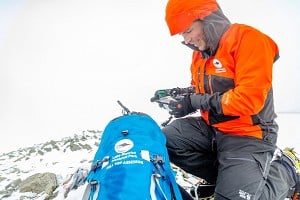In reply to jamesfrome:
I tried Cho Oyu (Normal Route from Tibet) without O2 and without support above BC in the post-monsoon season of 2000. I didn't summit but what I'd say is...
If coming from Nepal via the Friendship Highway (as I did) watch out for the day's drive to Nyalam (5000m+), just over the border in Tibet. This is a big ascent in a just few hours of driving and some of our team got AMS immediately and had to go back down. Plan on at least 2 days and nights rest at Nyalam, don't allow yourself to be rushed by your Operator. You will feel like shit and be prepared to drive down again if necessary - It's early days in the expedition so this may feel very frustrating, but if you scew up here and rush onto the Tibetan Plateau with AMS you could lose much more time.
Driving in jeeps across the Tibetan Plateau really is amazing - the world is now in 'widescreen format'!
The official BC is a dry grassy plain which is the 'end of the road' for jeeps, where the chinese military LOs stop never to be seen again until you finish your expedition. You then walk with Yaks to ABC (which is what climbers may regard as BC).
ABC to C1 is, as Axel says above, a non-technical, moraine covered and dry glacier, followed by a rubble strewn slog - a bit shitty TBH. C1 is rocky, and on a ridge line, so there isn't a huge number of good sites. I'd be tempted to try and get up there as soon as you can in order to get your tent pitched somewhere decent, before other teams bagsy the good sites. Following that drive to Nyalam, the daily ascent will have been much more mellow (with further days' rest on the plateau, and the approach walk) and we didn't have any issues acclimitising at this middle stage of the expedition. For this reason I'd suggest maybe pushing it a bit here if you feel OK, and get your tents up to C1. You can always dump your bags and turn around to ABC as its not such a huge day... so think about pushing it a bit.
C1 to C2 contains the 'crux' serac wall after a short ridge (maybe a short section of Scottish III when I was there). Let the commercial expeds fix this with ropes, or be prepared to get into an arguement if you go up first (which we did, and there were 'words'... ooops!). There are further fixed ropes across a big slope above this pitch which are easy (Scottish I?) but I was glad the ropes were there: its still quite hot midday at this altitude and the snow can be suncrusted and 'booming' as you walk (eeek!). The final bit to C2 at c.7000m is an absolute killer first time up - this is where you'll get to know what 'high altitude' feels like, rather than just the breathlessness and headaches of 5000m, or 6000m even. Carrying a big pack to C2 is a humbling experience if you're used to feeling fit and strong on the hills. If unsupported, I'd be tempted to plan on not returning to C1 same day if you've load carried to C2 for the first time - you might be too exhausted - this will mean initially taking more time at C1, maybe takes several shorter hikes above Camp 1 and returning for a few days before going for the carry to C2. C2 is a massive snow field, and there is no rush to get good spots for a tent. So, take your time at this point.
My ascent ended at C2, after 3 days being pinned down by high winds. The jet stream closed down the mountain for winter after that, and there was only one summit day that year, sadly when I was sat down at ABC.
What I do know, is that the summit day kinda starts from C2. There is a C3, but it's more of a rest point with a tent and a stove - not a fully equiped camp. The successful team that year (using O2) went up from C2 to C3 in the evening, rested for a few hours, then set off that night to push for the summit, having only spent a few hours at C3. Be aware that the true summit of Cho Oyu cannot be seen from the route below - the summit is apparently set back (c. 1km?) across a plateau after the 'climbing' and you must walk across this and get back and then re-locate your descent to C3, at least.
The successful 'climbers' that year were clients of a commercial expedition. They used O2, but more than that, they had 3x high altitude sherpas out in front, working in rotation to break trail and blast a path for them through the snow, across the summit plateau and back. To be safe I think you may need to have that kind of strength within your team at over 8000m. One member of our team was lucky enough to be high on the mountain on that summit day - he 'drafted' the sherpas and walked in the trail they broke for everyone else and got to the summit. So, was that unsupported? (Ha ha, I know what I think! Its maybe not just about bottles of O2 up there!).
Anyway, whatever you try, good luck and enjoy it!









